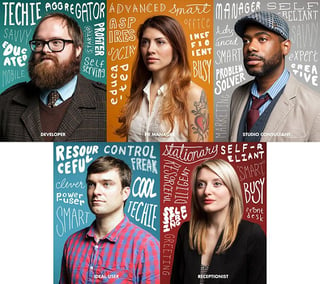
Nature vs. Nurture when creating Actionable Behavioral Personas
The web is seemingly flooded with companies describing their secret sauce for creating behavioral personas and how they can build them better than others. But, honestly, building personas is not even the hardest part. After working on multiple international & domestic persona projects for Fortune 1000 clients, it’s evident that the real journey begins when our clients inevitably ask the question, “Ok, we’ve got these personas, now what's next?”
As a UX [fill in the blank with all the job titles floating around there], our job is not to simply lock ourselves in a room to analyze a significant amount of behavioral data, and hand you a set of personas and call it a day. The differentiating factor between those that can build personas, and those that can make them actionable, lies in the ability to guide an organization on how to LIVE their personas. So what do you do after you've built behavioral personas
Next Steps After Building Behavioral Personas
In short, real UX Evangelists are worth their weight in gold because they can:
- Get the stereotypical buy-in from stakeholders
- Help you identify what this data really means to your organization
- Create the roadmap to nurture and iterate your personas
Let’s jump right in.
1. Buy-in from stakeholders.
No one likes being left out. Especially when being left out means that you’re not there when decisions are being made that directly impact how you define your customers. Big personalities, or individuals with a big title, can quickly become detractors from the goals and output of a project. Feeling like you didn’t have a seat at the table is a real concern when you consider the global scale of some of these undertakings.
To combat this, make sure that you shape your stakeholder interviews so they don’t feel like a formality. That means, making it less of a one-way series of scripted questions, and more of a dialogue/ideation opportunity. The goal is to discuss all aspects of the project, not just their individual involvement.
Often times a senior team member has that one thing that they really want to make sure they get across. Knowing, or anticipating, what this topic may be is critical to getting stakeholders to buy-in. Do your homework and show the relevance of how this engagement will directly contribute to their goals. These individuals are the gatekeepers to the time, effort, and resources your personas will need to succeed. Taking the time to tailor your conversation so that they don’t feel like you are going through the motions is a great way to win from within.
2. Socializing the information across your organization.
Synthesis of the data can really come as a challenge for teams and individuals who haven’t worked with personas before. We’ve seen this effort stymie any agile initiatives and undermine an organization's ability to act quickly on new data. After taking a look at root causes of why this happens, we see that socializing research is often times an underestimated endeavor. We’ve seen companies pull out all the stops and spend a lot of resources on a big engagement to develop and “get to know the personas”. Some build life size cutouts of their personas and create video monologues that play in a closed circuit in their reception area, but still don’t consider them during product design. Other companies simply send a mass email and say “Hey, it’s in your inbox”. These are obviously two ends of the spectrum and most would agree that the solution lies somewhere in the middle.
So where is that happy medium? Any hope of getting the right information, to the right people, at the right time, will be dependent on stakeholders willing to champion the research and create a sense of cohesion within the organization. This step reinforces the importance of stakeholder buy-in, the ones you worked with during the interviews, and will ultimately dictate the success of any persona engagement. These types of deliverables can’t survive as standalone items the same way an infographic would. Remember, time is not something you have, it’s something you make. Take the time to ask questions, and as a team, decide how these personas can help impact your goals.
3. Nurturing your personas.
Personas are the embodiment of your user archetypes and should be the muse for your team when making design, CRM, or any decisions that impact your customer journey. With such an important role to play in organizations, periodic maintenance to the personas ensures that the most relevant and available research helps contextualize them as the competitive landscape evolves. So how do we ensure that your deliverable will still resonate with the team, a month, 6-months, or a year down the road? Preparation and anticipation is key.
Defining the roadmap for future iterations of your personas will ultimately determine how effectively they will stand the test of time. Mapping in-house data and secondary research to feed into personas is critical to their longevity. If there is any concept capable of capturing the significance of what well-constructed personas can do for an organization, it’s this.
Behavioral Personas Recap
Contrary to popular belief, the perceived dirty work of creating personas doesn’t finish once you’ve collected the data. It’s important to be mindful that there are steps outside of quantitative and qualitative evaluation that can have significant effects on its success.
In summary:
- Identify the proper stakeholders and properly vet out their questions, concerns, and applicability of the findings to their individual needs. Once these key team members have been brought on-board and support the cause, you have set the proper foundation to build your research upon.
- You don’t need a big production to get everyone to buy-in to your research. But, you should do more than just send them an email with instructions on how to use personas. These outputs are intended to be used in a collaborative process; therefore, workshops where cross-pollination of ideas and truths based on the personas, and led by your stakeholders, are highly encouraged. This is a great platform to build team consensus and consider any future research initiatives.
- Like any worthwhile endeavor, sustained effort is the key to success. Building a roadmap that includes periodic checkpoints and the proper pipeline to supplement these findings is key. Personas are one of the most powerful tools Product Managers and Design Teams can have in their arsenal. However, it takes a top-to-bottom commitment from a team mature enough to value UX at the highest levels for this work.
So, you’re now ready to answer the important question, “Ok, we’ve got these personas, now what?”
READ MORE: Behavioral Persona Development: A Crash Course, 3 Ways to Incorporate Personas Into Every Department at Your Company, Incorporating a UX Strategy Into Your Business, Our Researchers Can Join Your Team












Comments
Add Comment